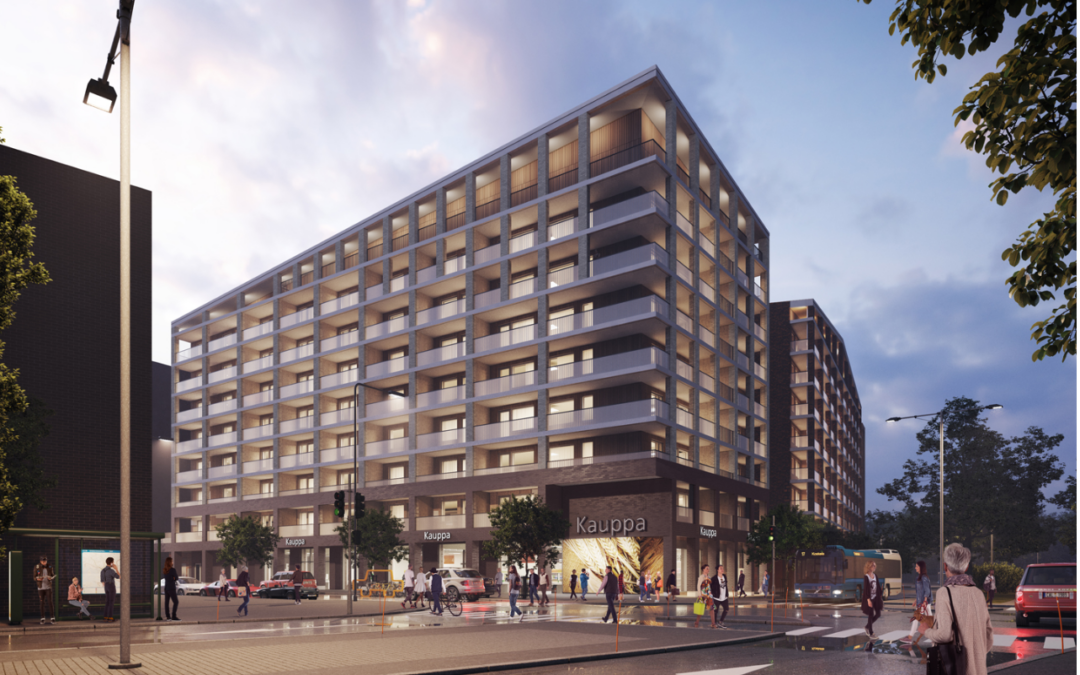Energy technology company Oilon and Helen, One of Finland’s largest energy groups, have received the esteemed Heat Pump Award in the DecarBuilding series for their jointly-developed heat pump solution. Granted by the European Heat Pump Association (EHPA) since 2011, the award serves to recognize the most innovative and energy-efficient heat pump projects in the continent. The award ceremony took place in Brussels in October 2022.
The award-winning project involved a heating and cooling solution for a new apartment building. Completed in 2021, the system utilizes the building’s waste heat in various ways. The building, which is located in Helsinki’s Postipuisto district, has a total of 113 apartments as well as a grocery store.
The beating heart of the system is a high-capacity heat pump. Besides ground source heating, the unit can utilize waste heat from the building’s waste water and apartment cooling as well as the grocery store’s refrigeration equipment. The recycled energy is used for heating the building, producing domestic hot water, and, in the summer months, for apartment cooling. District heating is used for backup in case there is a fault and to provide supplementary heating during the coldest days of winter. On days when the building generates more heating than it consumes, the surplus heat can be sold as district heating and channeled into Helen’s district heating network.
Recycling makes sense even in energy production
Developed jointly by Oilon and Helen based on the principles of circular economy, the new hybrid solution sets a new standard for the energy efficiency and environmental impact of new buildings. The solution is the result of long-term product development between the partners, with a unified focus on heat pump technology and waste heat recovery. The most innovative aspect of the system is that different heat sources can be utilized in different combinations at different times of the year, resulting in optimal performance and minimizing the building’s carbon footprint. This is made possible by an Oilon ChillHeat heat pump, which can adjust its output intelligently from very low levels to maximum capacity within a wide range of temperatures.
The adoption of bidirectional energy production and consumption is part of the trend that drives building heating and cooling towards improved sustainability. Oilon’s heat pumps play a key part in this development: they allow companies and property owners to utilize renewable energy sources and waste heat. Additionally, they are an excellent fit for smart networks and electricity-based energy production.
Excellent experiences from the first year of operation
Antti Leskinen, who serves as the project lead for Helen, describes the Postipuisto pilot project as a wonderful and interesting yet challenging undertaking. The success of the project is based on careful planning. The companies have a long history of shared innovation in waste heat recovery, which served as solid groundwork. In Helsinki, for example, Helen extracts heat from waste water at the Katri Vala heat pump plant, the largest of its kind in the world.
“There were no major issues with the Postipuisto system in its first year of operation. We kept a close eye on energy streams and system operation and fine-tuned the system along the way, exactly as planned,” Leskinen says.
Two energy sources rose above the others: condensation heat from the grocery store and ground source heating. Additionally, the system recovered considerable amounts of energy from wastewater and apartment cooling. In summer, the heat pump transfers surplus heat to boreholes for storage. In the coldest days of 2022, district heating was used to even out peaks in power consumption. Versatile, flexible, and responsive energy use creates new opportunities for housing construction in the future.
“For Helen, Oilon is a long-standing and reliable heat pump partner. They have deep understanding of the field, which is evident in the quality of their products and, for example, the way they implemented the automation system for this complex system,” Antti Leskinen says.
Annual emission reduction: 137 t CO2

Postipuisto apartment building (Rullakkokatu 1, Helsinki). The reduction in carbon dioxide emissions from heating, domestic hot water and cooling based on actual consumption compared to typical emissions for 2021 declared by Helen.
Technical data: Energy solution used in the Postipuisto apartment building (Rullakkokatu 1, Helsinki)
Heat sources: Ground source heating, waste water, condensation heat from a grocery store’s refrigeration equipment, apartment cooling. District heating as a secondary and backup heat source. District heating evens out energy peaks in the coldest days and accounts for approximately 1/3 of the building’s annual heating.
Heat sink: Heating, domestic hot water, and the local district heating network.
Cooling sources: Domestic hot water production and boreholes for ground source heating.
Cooling sink: Apartment and space cooling.
Cooling capacity: 100 kW (7/12 °C and 40/80 °C), COPtot 4.9.
Heating capacity: (ground source heating) 115 kW (0/3 °C and 30/55 °C), COPh 3.2.
Energy class: Class A building, annual consumption 9500 mq < 75 kWh/m2.
The system’s 16 ground source heat pump boreholes are used for thermal storage.
In summer months, solar panels provide a portion of the electricity used by the building’s systems.
The system’s 16 ground source heat pump boreholes are used for thermal storage.
In summer months, solar panels provide a portion of the electricity used by the building’s systems.

Learn more about Oilon heat pumps here.

